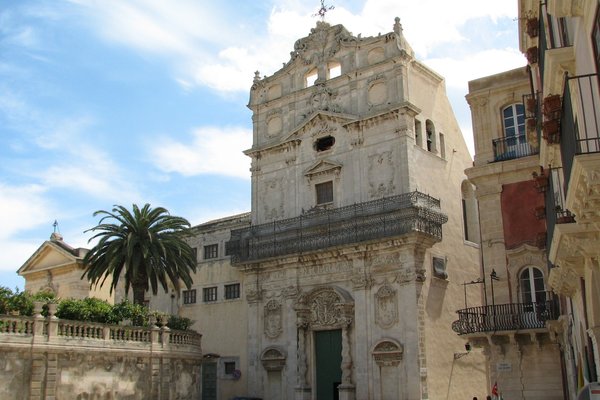Italy
Syracuse
Syracuse and the rocky Necropolis of Pantalica bear testimony to the development of Mediterranean civilization in the past 3000 years.
Syracuse was one of the greatest Greek colonies. The remains from that period can be found on the island of Ortygia and at the archeological park of Neapolis. Later civilizations, such as the Byzantines, Arabs, Normans, Bourbons and Aragonese also left their mark on Ortygia. The Necropolis of Pantalica lies 40km away and holds rock-cut tombs made by indigenous people of Sicily.
Community Perspective: Ortygia is a pleasure to explore on foot and its Duomo is recommended for a visit as it has developed constantly like the city, from the Ancient Greek to the Baroque. The Necropolis at Pantalica is “nothing special”, and Alikander made it to the third component of this eclectic site, the archeological park of Neapolis.
Site Info
Official Information
- Full Name
- Syracuse and the Rocky Necropolis of Pantalica (ID: 1200)
- Country
- Italy
- Status
-
Inscribed 2005
Site history
History of Syracuse
- 2005: Inscribed
- Inscribed
- Type
- Cultural
- Criteria
- ii
- iii
- iv
- vi
Links
- UNESCO
- whc.unesco.org
- Official
-
- visitsicily.info — Visit Sicily
- Related
-
- bestofsicily.com — Best of Sicily
- sicilyweb.com — About Pantalica
All Links
UNESCO.org
- whc.unesco.org — whc.unesco.org/
Official Website
- visitsicily.info — Visit Sicily
Related Resources
- bestofsicily.com — Best of Sicily
- sicilyweb.com — About Pantalica
Community Information
- Community Category
- Archaeological site: Ancient Rome
Travel Information
Recent Connections
-
Depot for artwork during war
Euryalus Castle: "In 1941, during the S…
-
Perfect Inscriptions
2005 -
Mentioned in Moby Dick
".. that still more wonderful story of …
Connections of Syracuse
- Individual People
-
-
Charles V
"In 1538, Charles V abolished the Camera Reginale and Syracuse became a real military stronghold, vital in the struggle between the Spanish and Turkish Empires. In 1527, he began the building of the great fortifications of Ortygia which will stand for 300 years." (Nomination file, p. 59) -
Alexandre Dumas
Dumas recounts his visit to Sicily in his work "Le Speronare", during which he visited Catania, Syracuse, the Valley of the Temples in Agrigento and ascended the Etna.See fr.wikipedia.org
-
Goethe
Italian Journey -
Caravaggio
"Burial of St. Lucy" in the church of Santa Lucia al SepolcroSee en.wikipedia.org
-
Belisarius
Syracuse was conquered by Belisarius in 535 for the Byzantine Empire. (Nomination file, p. 145) -
Frederick II
"(...) under the direct rule of Frederick II, Syracuse was given the title of 'fedelissima', and the Emperor built Castello Maniace to defend the city and the harbour between 1232 and 1240." (Nomination file, p. 58)
-
- Geography
- Trivia
-
-
Cultural sites taking up an entire island
Ortygia -
Fatal Accidents or 'disasters'
One night in December 1704, during a very strong storm, lightning struck the Castello Maniace in Syracuse, blowing up its powder magazine (800 barrels), destroying its watchtowers, causing an entire floor to collapse and killing 33 Spanish soldiers who, as usual, garrisoned it, even at night. (wiki)See it.wikipedia.org
-
Built or owned by Spanish
he era of Charles V was marked by the war against the Ottoman Empire. Syracuse, as a borderland between the western and eastern Mediterranean, became a fundamental pivot for defending the Spanish imperial borders. Charles V, therefore, had it fortified in such a powerful manner that it assumed, from that moment on, the nickname of fortress. The transformation of Ortigia into an island also dates back to the work of the Spanish soldiers of Charles V, since they cut the isthmus that the Greeks had built about a thousand years earlier, thus returning Ortigia to its original geographical shape.See it.wikipedia.org
-
Dubbed 'White City'
The architecture of Syracuse almost always shows white facades, tending towards beige or yellow-gold, since they were built with the Iblei stone. For this reason Syracuse is often called, architecturally, the "white city". (wiki)See it.wikipedia.org
-
- History
-
-
Republic of Genoa
After the Norman conquest of Sicily, a "period of anarchy and violence followed, as the Pisans and Genoese controlled the city, (...)" (Nomination file, p. 58) -
Byzantine Empire and Civilization
After a period of Vandal rule, 469–477, Syracuse and the island was recovered for Roman rule under Odoacer, 476–491 and Theodoric the Great, 491–526, by Belisarius for the Byzantine Empire (31 December 535). From 663 to 668 Syracuse was the seat of the Greek-speaking Emperor Constans II, as well as a capital of the Byzantine (Eastern Roman) Empire and metropolis of the whole Sicilian Church. (wiki) -
Hellenistic Greece
"The authenticity of Syracuse is evident in many of the city's structures, which retain the same characteristics as during the late Hellenistic period (...) The original Hellenistic system and the changes that occurred during the various historical periods have made it possible to clearly distinguish the evidence left in each age and how each culture operated and interacted with the pre-existing ones." (Official description) -
Pentapolis
"Ortygia consisted of five parts, giving rise to its alternative name of Pentapolis." (AB Ev) – "the city, rich and powerful, was divided into five areas, (the 'pentapolis' about which Cicero spoke) - Achradina and Tycha both residential areas, Neapolis, rich in monumental buildings, Epipoli, with a strategic function and Ortygia reserved for the tyrant. (Nomination file, p. 145) -
Archaic Greece
"Ancient Syracuse, includes the nucleus of the city's foundation as Ortygia by Greeks from Corinth in the 8th century BC." (Official description) "It has been possible to demonstrate how this town plan has survived today in many areas of Ortygia, which thus becomes an extraordinary example of how the aggregation and organisation of the town over the centuries still clearly maintains its Archaic Greek mould." (Nomination file, p. 55) -
Ancient Greek colonies
-
Sieges and Battles
Athenians 415BC (lifted), Romans 213/2BC, Arabs 878 -
Normans
"The later Norman conquest (1086) relegating Syracuse to the role of a city of secondary importance, strengthens more and more Palermo as capital of the island." (Nomination file, p. 147) Some buildings date back to the Norman period, e.g. the Church of San Martino on Ortygia. (wiki)See it.wikipedia.org
-
Depot for artwork during war
Euryalus Castle: "In 1941, during the Second World War, the artefacts in the Syracuse archaeological museum were carried by mule to the fortress and hidden in its tunnels, so that they would be safe from aerial bombardment." (Wikipedia)
-
Located in a Former Capital
Due to a political plan desired by Constans II, Syracuse became the capital of the Byzantine Empire in place of Constantinople, from 663 to 668. (wiki)See it.wikipedia.org
-
Bronze Age
"The archaeological explorations of the square in front of the Cathedral have shown that this location was the site of cults in honour of unknown divinities in the Ancient Bronze Age, where the Corinthian Oikos was received, the official cult location with which the founding of the city was sanctioned." (Nomination file, p. 135) -
Knights Hospitaller
In 1529 the Order of the Hospitaller Knights of St. John of Jerusalem moved to Syracuse, either by demand of Charles V himself or on the initiative of Grand Master Philippe de Villiers de L'Isle-Adam. The knights errant, having no fixed abode after the loss of the island of Rhodes, remained in Syracuse for an entire year, until they received, in April 1530, the documents granted by Charles V, as king of Sicily, on the enfeoffment of the archipelago of Malta to their Order. (wiki)See it.wikipedia.org
-
- Architecture
-
-
Designed by Luigi Vanvitelli
The centre of the chapel of the Blessed Sacrament features a gilded wooden tabernacle (or ciborium) in the shape of a small temple, the work of the Neapolitan painter-architect Luigi Vanvitelli. (Wikipedia)See it.wikipedia.org
-
Baroque
"The group of monuments and archaeological sites situated in Syracuse (between the nucleus of Ortygia and the vestiges located throughout the urban area) is the finest example of outstanding architectural creation encompassing several cultural influences (Greek, Roman and Baroque)." (Official description – Criterion iv) – A remarkable example of Baroque architecture is the façade of the Cathedral, classified as "High Sicilian Baroque"See en.wikipedia.org
-
Rock Cut Architecture
Pantalica -
Octagons
The sanctuary of Santa Lucia al SepolcroSee it.wikipedia.org
-
Mosaic art
Syracuse Cathedral has mosaics of Norman origin in the chapels.See en.wikipedia.org
-
Rococo
The works on the Cathedral were completed in two periods and for this reason it presents, according to many, two ornamental styles; the baroque style and the rococo style. The first works began in 1728 and were completed in 1731. Then there was a pause of twenty years and it resumed in 1751, probably this is the period in which the late Baroque gives way to the Rococo style. The facade was completed in 1753. (wiki)See it.wikipedia.org
-
Spolia
The cathedral (Italian: Duomo) was built by bishop Zosimo in the 7th century over the great Temple of Athena (5th century BC), on Ortygia island. This was a Doric edifice with six columns on the short sides and 14 on the long sides: these can still be seen incorporated in the walls of the current church. (wiki) -
Hypostyle
Castello Maniace: "Of the original hypostyle hall, into which streamed light from 15 wall windows, one large window to the sea on the west side and from the central compluvium open to the sky, only the south side remains." (Nomination file, p. 85) -
Reinforced Concrete
The Fountain of Diana was built in reinforced concrete, both due to lower construction costs but also to follow the wide versatility that this construction technique allowed to be implemented. (wiki)See it.wikipedia.org
-
Grotesques
The central portal of the Cathedral is surrounded by a semicircular tympanum with an arched shape which is surrounded by floral motifs represented by garlands and grotesque masks. (wiki)See it.wikipedia.org
-
Gothic
"At the end of the 14th century, (...) the favourite architectural style" became "the Chiaramontana style, an original interpretation of the Gothic. The Palazzi Nava, Abela, Chiaramonte and Montalto, and the churches and monasteries of S.Benedetto, S.Francesco and S.Domenico are this period's contributions to the cityscape." (Nomination file, p. 59)See en.wikipedia.org
-
- Damaged
-
-
Damaged in World War II
Heavy destruction was caused by the Allied and the German bombings in 1943 -
Blown up
One night in December 1704, during a very strong storm, lightning struck the Castello Maniace in Syracuse, blowing up its powder magazine (800 barrels), destroying its watchtowers, causing an entire floor to collapse and killing 33 Spanish soldiers who, as usual, garrisoned it, even at night.See it.wikipedia.org
-
Destroyed or damaged by Earthquake
The city was struck by two ruinous earthquakes in 1542 and 1693 (same as Val di Noto)
-
- World Heritage Process
-
-
Incorrect UNESCO 'Number of locations'
3 locations listed, but the map for location 2 shows more parts that are isolated from others by the buffer zone -
Perfect Inscriptions
2005
-
- Religion and Belief
-
-
12 Apostles
By tradition, Saint Peter founded a church in Syracuse. Syracuse is now the seat of the Roman Catholic Archdiocese of Siracusa.See en.wikipedia.org
-
Mentioned in the Bible
Acts 28:12 - Paul lands and stays for 3 days on way to Rome -
Cathedrals
"The Cathedral was built by bishop Zosimo in the 7th century over the great Temple of Athens (5th century BC), on the Ortygia island. This was a Doric edifice with six columns on the short sides and 14 on the long ones: these can still be seen incorporated in the walls of the current church." (Wiki) -
Nymphaeum
above the Greek Theatre -
St Paul was here
Paul is said to have made a stop in Syracuse for three days and to have even brought christianity to Sicily. Following Acts of the Apostles, 28:11-13: "After three months we put out to sea in a ship that had wintered on the island. It was an Alexandrian ship with the figurehead of the twin gods Castor and Pollux. We put in at Syracuse and stayed there three days. From there we set sail and arrived at Rhegium." Supposedly he preached at the place where now the Chiesa di San Giovanni Battista stands. -
Legends and Folk Myths
Ear of Dionysius: the tyrant "Dionysius used the cave as a prison for political dissidents, and by means of the perfect acoustics eavesdropped on the plans and secrets of his captives. Another more gruesome legend claims that Dionysius carved the cave in its shape so that it would amplify the screams of prisoners being tortured in it"See en.wikipedia.org
-
Mikveh
"The oldest and largest mikveh in Europe was discovered, just a few decades ago on Ortygia, in Syracuse, Sicily, ten meters under the Hotel alla Giudecca. The "Casa Bianca" mikveh was most likely built during the Byzantine period and was probably in use from the 7th to the 15th century. Its five immersion pools ..." + Ortygia has two other mikvehs, one under the church of San Filippo Apostolo, and one under a private residence in the Olivo neighbourhood. (wiki)See mfopen.mf.no
-
Benedictines
Church of Santa Lucìa alla Badìa: a "church and monastery at the site, attached to a female Benedictine monastery was present by the mid-15th century (...) The monastery and church were destroyed by the 1693 Sicily Earthquake."See en.wikipedia.org
-
Carmelites
During its history, St John's Basilica was given to "the Carmelites of Montesanto who made new modifications to the structure". (Nomination file, p. 95) – Also the Chiesa del Carmine with its Carmelite convent on Ortygia.See it.wikipedia.org
-
Cistercian
The Church of Santa Lucia alla Badia was entirely destroyed by the earthquake of 1693, and the reconstruction can be attributed to the mother abbess of the Cistercian nuns between 1695 and 1703. (Wikipedia)See it.wikipedia.org
-
Early Christianity
"The Catacombs, the largest except for those in Rome, date from the paleochristian period." (AB Ev) – "The St Lucy Catacombs (...) are the earliest in the city and date from 220-230 AD." (Nomination file, p. 92) - The church of San Giovanni alle catacombe was built in the area above the Catacombs and in the place where, according to tradition, the protobishop of Syracuse San Marciano, martyred under Gallienus and Valerian, was buried (mid-3rd century).See it.wikipedia.org
-
Franciscan Order
San Francesco all'ImmacolataSee en.wikipedia.org
-
Jesuit Order
"Church of the Collegio (built by the Jesuits in the 17th century)" (AB Ev)See it.wikipedia.org
-
Jewish religion and culture
The Jewish community settled in the Giudecca quarter on Ortygia until 1492, having built the synagogue and mikvehs in that area. (wiki)See it.wikipedia.org
-
Marian Shrines
The church of Santa Maria dei Miracoli "was built at the site of a prior church dedicated to St George (...). The new dedication was adopted when icon of the Madonna, housed in the church, was said to have led to the cessation of a season of the plague in 1500–1501." (wiki)See en.wikipedia.org
-
Converted Mosques
The Cathedral of Syracuse "was converted into a mosque in 878, then converted back when Norman Roger I of Sicily retook the city in 1085." (wiki)See en.wikipedia.org
-
Nunneries
Santa Lucia alla Badia -
Religious Relics
"As of 2015 the cathedral holds a number of relics of St. Lucy, the patroness of the city: a number of bone fragments, a robe, a veil, and a pair of shoes." (wiki)See en.wikipedia.org
-
Sacred Forests or Groves
Altar of Hieron: "To the west of the altar there was a rectangular open space with a water-proofed basin in the centre, surrounded by a u-shaped stoa. (...) In Augustan times, this open space was planted with trees in order to turn it into a sacred grove." (wiki)See en.wikipedia.org
-
Theatines
"the Convent of the Teatine Fathers together with St Andrew's and St James' Church is pulled down in 1872 leaving space for the Archimedes' Square of today in the centre of Ortygia." (Nomination file, p. 151)
-
- Human Activity
-
-
Papyrus
Papyrus museum (by the end of the 18th century Syracuse had started to produce papyrus, ... on the Ciane River, of the only papyrus plants in a natural state in Europe) -
Piracy
Castello Maniace was used to counter pirate incursions.See it.wikipedia.org
-
Sea Ports
"Ortygia, originally a peninsula, is positioned from North to South dividing two strips of sea and thus forming two natural ports. One to the NE called "Porto Piccolo" (Small Port) and the bigger one to the West, which is appropriately called 'Porto Grande' (Big Port)." (Nomination file, p. 53) -
Stone Quarries
"Recent calculations estimate that about 4.700.000 m3 of stone have been extracted from the 12 Syracusan quarries. The quarries, or latomies (litos = stone and temnos = cut) were in fact immense caves of stone from which the necessary materials were extracted for the building of the city and its monuments. The quarries spread over about 1.5 km in a curved line that follows approximately the border of the limestone plateau which dominates the coastal plain towards Ortygia, starting from the vicinity of the Greek Theatre until the sea, near the Capuchin Convent. The extractions were usually made in the open air, and traced the layers of the more compact rock as deep as 40 m, digging immense grottoes below the rocky layers of the surface crust supported by enormous pillars. As reminded by Cicero who defined them as safe places against any attempt of evasion, the quarries were perfect for keeping prisoners who were condemned to dig masses. In particular, historians tell of the Carthaginians captured by Gelone at Imera in 480 BC and the 7000 Athenians who survived the massacre of 413 BC. But the quarries also served as dwelling places for the more humble sects and also as funeral corporations, evidenced by the presence of many votive squares cut into the walls dedicated to the deceased. The quarries offered also an excellent form of defence for Syracuse and Neapolis" (Nom File) -
Grand Tour
Syracuse was a destination for travellers of the Grand Tour in the 18th century, and even more so in the 19th century. (wiki)See it.wikipedia.org
-
- Constructions
-
-
Beehive tombs
In the San Martino necropolis in PantalicaSee it.wikipedia.org
-
Tombs
The alleged tomb of Archimedes is an artificial cave dug out of limestone, located inside the Grotticelle necropolis. Its fame is due to the popular tradition which would place in this cavity the burial of the famous Syracusan Archimedes. In reality, it is quite unlikely that the tomb in question corresponds to the real tomb of Archimedes. Cicero, an ancient source, left evidence of the real burial place of the great scientist, which does not correspond to the location where the alleged tomb is located. (wiki)See it.wikipedia.org
-
Catacombs
The main Syracusan catacombs are the St Lucy Catacombs, the Vigna Cassia Catacombs and the Catacombs of St John's Basilica. (Nomination file, p. 92-93) -
Theatres and Opera Houses
ancient Greek theatre -
Monumental Fountains
Fountain of ArethusaSee en.wikipedia.org
-
Triumphal Arches
Remains of the Augustan Arch of Syracuse in the Archaeological Park of NeapolisSee it.wikipedia.org
-
Hypogea
Ipogeo di Piazza Duomo -
Ossuary
Under the church of San Filippo Apostolo there is a crypt with an ossuary.See it.wikipedia.org
-
Aqueduct
The "large artificial grotto called "Nympheo" (...) has a vaulted ceiling and a rectangular bath, covered with potsherd, into which pours water from a branch of a Greek aqueduct." (Nomination file, p. 106) – "The water that flows into the Grotta derives from two separate aqueducts, both of Greek date; one is called the Acquedotto del Ninfeo (Nymphaeum Aqueduct) after the Grotta, while the other is the Galermi Aqueduct."See en.wikipedia.org
-
Roman amphitheatres
Roman amphitheatre -
Prison
Castello Maniace was used as a prison in the 15th century.See en.wikipedia.org
-
Lighthouses
The lighthouse of the Castello Maniace, which is green in colour (just as its light is green) (wiki)See it.wikipedia.org
-
Necropolises
Necropolis of Pantalica -
Cisterns
Euryalus Castle: "Inside there are three large cisterns for the troops' water supply in the case of a siege." (Nomination file, p. 123)
-
- WHS on Other Lists
-
-
Located in a TCC Territory
Sicily
-
- Timeline
-
-
Built in the 8th century BC
Syracuse: "From the ancient Greek period to the Baroque" - founded ca. 734 B.C. -
Built in the 2nd Millennium BC
Necropolis of Pantalica: "Most of the tombs date back to the period from the 13th to the 7th century B.C." (AB ev)
-
- WHS Hotspots
- Science and Technology
-
-
Early Archaeology
Altar of Hieron: "Amateur archaeological excavations were undertaken by Giuseppe Maria Capodieci in 1780, Saverio Landolina in 1813, and F.S. Cavallari in 1839. The only systematic and scientific excavations of the site were undertaken by Robert Koldewey and Otto Puchstein in 1893." (wiki)See en.wikipedia.org
-
Archaeological potential
"(...) there are still great possibilities for research both in the vast necropolises with the rock-cut tombs of the various periods of the Pantalica culture, and in the area of the so-called Anaktoron. Here the necessity to explore the area to the west of the monument and above all, the area all round it becomes pressing, to discover traces of the prehistoric settlement that it must have ruled over." (Management plan, p. 96) -
Scientific Developments
The Greek mathematician and inventor Archimedes was born in Syracuse, where he lived his whole life. "Archimedes anticipated modern calculus and analysis". His "other mathematical achievements include deriving an approximation of pi, defining and investigating the Archimedean spiral, and devising a system using exponentiation for expressing very large numbers. He was also one of the first to apply mathematics to physical phenomena, working on statics and hydrostatics." Apart from this, he "is also credited with designing innovative machines, such as his screw pump, compound pulleys, and defensive war machines to protect his native Syracuse from invasion." (wiki)See en.wikipedia.org
-
Libraries
Biblioteca AlagonianaSee it.wikipedia.org
-
- Literature & Film
-
-
Indiana Jones movie
Indiana Jones and the Dial of DestinySee www.geo.fr
-
Mentioned in Moby Dick
".. that still more wonderful story of the Arethusa fountain near Syracuse (whose waters were believed to have come from the Holy Land by an underground passage); these fabulous narrations are almost fully equalled by the realities of the whalemen." (p147) -
Poetic Quotations
John Milton about the Fountain of Arethusa in "Lycidas" (l. 85): "(...) O Fountain Arethuse, and thou honour'd flood, / Smooth-sliding Mincius, crown'd with vocall reeds, / That strain I heard was of a higher mood: / But now my Oate proceeds, (...)" (see link for source) -
Literature
"Criterion (vi): Ancient Syracuse was directly linked to events, ideas and literary works of outstanding universal significance." (Official description)
-
News
No news.
Recent Visitors
Visitors of Syracuse
- 4lex
- Adolfo
- Adrian Turtschi
- Afshin Iranpour
- Alexander Barabanov
- Alexander Lehmann
- alicemears
- Alikander99
- ALS
- Ammon Watkins
- Ana Lozano
- Argo
- Artur Anuszewski
- Ask Gudmundsen
- Aspasia
- Atila Ege
- Badwater
- BaziFettehenne
- Bill Maurmann
- Bin
- Birgitte Sørensen
- Bram de Bruin
- Bropyk
- butterflybird
- canadiantraveller
- Caspar
- Cezar Grozavu
- chenboada
- chenqtao
- chiuliqi
- ChrisN
- Christian Wagner
- christof
- Christoph
- Cirene Moraes
- Claire Bradshaw
- Clyde
- Col
- Cristina Erba
- CugelVance
- czesioszpachelka
- Dani Cyr
- Daniela Hohmann
- Daniel Chazad
- Dan Pettigrew
- David Berlanda
- del
- Dimitar Krastev
- Dimitrios Polychronopoulos
- Doubanjiang
- Dr. Caligari
- Echwel
- Elia Vettorato
- eljx1988
- Els Slots
- Emilia
- Emili Xaus
- Erfe91
- Eric Lurio
- Erik Jelinek
- Eva Kisgyorgy
- Evgenii
- Fan Yibo
- Farinelli
- fedemarch92
- Federico P.
- Feldhase
- Felicité
- Femke Roos
- Fernweh
- Filip Murlak
- Flexiear
- Fmaiolo@yahoo.com
- FS
- Geert Luiken
- George Gdanski
- GeorgeIng61
- giulio25
- grimloch
- Hadrianus
- Hammeel
- Harald T.
- Harry Mitsidis
- H Beswick
- Hubert
- Iain Jackson
- Ian Cade
- Igloo
- Ilya Burlak
- Ivan
- Ivan Rucek
- Jacob Otten
- Jakob F.
- Jakubmarin
- Jana and Matt
- janem
- Janina Lehmann
- Jasam
- Jawnbeary
- Jeanne OGrady
- Jens
- Jezza
- João Aender
- Joel on the Road
- Jonas Kremer
- JoStof
- JR's HERITAGE SITES
- Juha Sjoeblom
- Jurre
- Karito Vies
- KeithBailey
- Ken DJ
- KentishTownRocks
- Kerékgyártó
- Klara Woodson
- ko9757
- Krijn
- Krzysztof B
- La Concy
- Lado Joel
- Lameduck99
- Lara Adler
- LaVale
- Liamps91
- Lisu Marian
- Loic Pedras
- Luboang
- Lucas Del Puppo
- Lucio
- Ludvan
- Luis Filipe Gaspar
- Lukasz Palczewski
- Maciej Gil
- Maciej Gowin
- Malgorzata Kopczynska
- Małgosia Łupicka
- Manon R
- Manuelfunk
- MarcoB_0
- Martin
- Martina Rúčková
- Marton Kemeny
- Matejicek
- Mateusz
- Matthewsharris
- MAURO PODDA PANI
- Max
- MaxHeAnouBen
- MaYumin
- MH
- MichaelH
- Michael Novins
- Mikko
- Mikko Syrjä
- Milan Jirasek
- Ming_9734
- Mo-han Je
- Monica Tasciotti
- MoPython
- nan
- Nasebaer
- Nihal Ege
- opperpco3
- PabloNorte
- Patrik
- Paul Schofield
- Peltzi
- Persian Globetrotter
- PeterH
- Peter Lööv
- Philipp Leu
- Philipp Peterer
- phillipmeng
- Pierre T
- Pink Bunny
- Piotr Wasil
- PlacesWeHaveBeenTo
- preunesco
- Priyaranjan Mohapatra
- puessergio
- Purrfect
- Rafał Kałczuga
- Rahelka
- Ralf Regele
- Randi Thomsen
- reddargon
- Reiseblog
- Reisedachs
- Remigiusz
- Reza
- rivr
- RobRos
- Roccobot
- Roel Sterken
- Roger Ourset
- Roman Bruehwiler
- Rudegirl
- Sabrina Liebehentschel
- Samato
- Samy G
- Sandmann15
- Sandra!
- Schnitzel
- Sergio Arjona
- Shandos Cleaver
- Simonf
- SirLoydd
- Slavi
- Solivagant
- Ssong.x
- Stanislaw Warwas
- stephanvermeulen
- Stijn
- Sutul
- Svein Elias
- Szabolcs Mosonyi
- Szabo Viktoria
- Szucs Tamas
- Taotao Chen
- Tarquinio_Superbo
- Tevity
- thisispivi
- Thomas Buechler
- Thomas van der Walt
- Tim Allen
- Timothy C Easton
- Tom Flaten
- tony0001
- Tony H.
- tquist24
- travellingcat
- triath
- Truls Brekke
- Tschibi
- Tsunami
- Twobaconsandaboston
- usagi1974
- Valentina
- ValiaVeweth
- Vanessa Buechler
- Van Hung
- Viaje al Patrimonio
- vino4vino
- V&M
- voyager
- Waxwing
- WILLIAM RICH
- Wojciech Fedoruk
- Xander Huang
- Xiquinho Silva
- yasdeb
- Yevhen Ivanovych
- Zizmondka
- Zoë Sheng
- Zsuzsanna Forray
Community Reviews
Show full reviews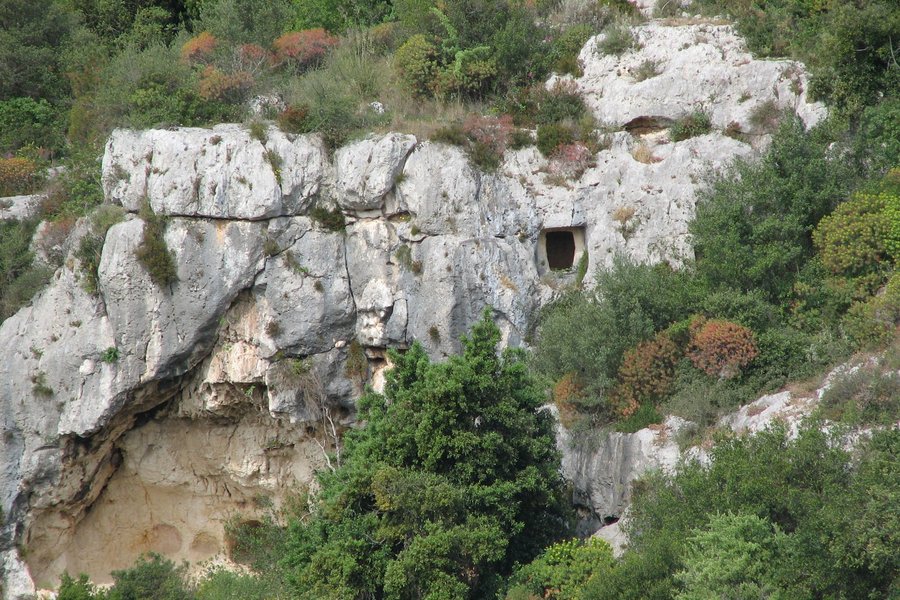
I just realised no one here has actually gone to the neapolis archaelogical park, which is one of the 3 main components of the site so...i'll give my impression.
The archaelogical site IS unfortunately nothing too impressive. I recall a Big greek theatre, a small Roman aphiteatre (both in a somewhat patchy state especially for Italy) and the ancient limestone quarries. Mostly I just walked around the ruins. It's not bad but I would say selinunte or agrigento are much better places to get a feel of the greek past of the island.
Nearby you can go check the catacombe di san Giovanni. They're pretty big and still has a few frescoes. I found them plenty interesting though I haven't visited many paleochristian necropolis to compare them too. I can say it's bigger but roughly of the same quality as the ones I saw in malta. In fact I wonder if they could be added to malta's twhs as a transnational nomination as they're typologically very similar.
Across the road you'll find the basílica santuario Madonna delle lacrime. A pretty interesting (and very photogenic) brutalist church.
I did not visit the necropolis of pantalica but I agree that ortigia IS the main element in the site anyway and it warrants inscription on its own given its importance and good conservation state. I found The temple turned Cathedral particularly enthralling and unique. The rest of the island holds a good baroque ensemble.
Keep reading 0 comments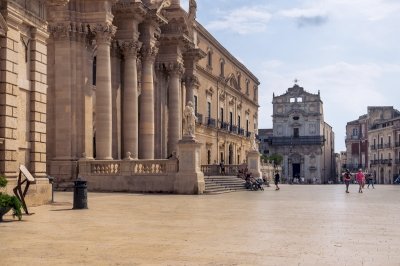
Our trip to Sicily in September of 2021 budgeted time only for Ortigia, the historic nucleus of Syracuse that has been continuously inhabited for over 3,000 years. The island is very walkable and reasonably compact, high on the historic-feel quotient with a non-trivial measure of decay and lack of TLC, and decidedly short on killer features.
The walk around town will bring you to the Temple of Apollo ruins, the Ortigia street market, the natural spring of Arethusa, the 13th-century Maniace military fort, and other easy on the eye perspectives. Views over the water on the southeastern edge of Ortigia, where the crescent of Lungomare d'Ortigia leaves room for a sliver of a beach are my favorite. Piazza del Duomo is by far the widest public space on the island, presided over by the cathedral that incorporates in its structure the remnants of the Greek Doric Temple of Athena, built on this same site all the way back in the 5th century BCE.
There are also many examples of Baroque both at churches and in civic architecture. (Syracuse happens to be geographically closer to Noto and Ragusa than Catania is, so obviously some rebuilding after the earthquake of 1693 for which "Baroque Towns of Val di Noto" are celebrated occurred here as well.)
We spent over half a day in Ortigia, which is the least it deserves. Several museums - none that I believe are of "must-see" variety - could be worked into the itinerary for a …
Keep reading 0 comments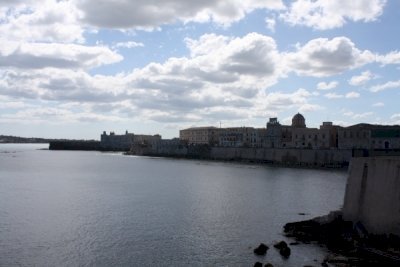
March 2019, the 2nd last day of our Sicily Trip we arrived in Syracus. Unfortunately we only visited that part of the WHS. With our baby we strolled around the city and watched our for some seafood. It is a very historic and nice town, however loaded with Restaurants and not many places to rest. However, there are a lot of streets to explorea dn some nice little shops too.
It was a good place to conclude our Sicily trip. 7 WHSites, 1 Tentative, Lots of good food and the first trip with our small girl. We enjoyed it a lot.
Keep reading 0 comments
Visited in May 2014. I spent half a day in the historic center of Syracuse located on Isola di Ortigia, so, I have not seen other parts of this WHS that might be more interesting and more important in respect to OUV than Ortigia.
It was pleasent day strolling in the narrow streets and enjoying views to Ionian sea... However, I must say I prefer other towns in Sicily, especially those located on the top of hills or in the deep valleys such as nearby Ragusa Ibla, Modica and Scicli (also WHS) and many many others.
In conclusion: the best from Syracuse what I keep in my memories: (1) visiting somehow odd cathedral blending together everything from antiquity to baroque, and (2) enjoyng cappuccino&cornetto di crema and handsome Sicilian boys all around...
Keep reading 0 comments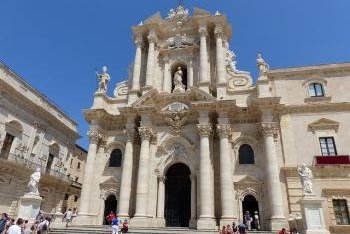
I visited this WHS in May 2015. The rock-cut tombs of Pantalica are nothing special visually and I had more fun hiking in the Mediterranean environment rather than actually enjoying what's left to see of these tombs. On the other hand, Syracuse in general but specifically the sites in Ortigia are a great summary of what Sicily has to offer ... temples, amphitheatres, remains, baroque churches, great food, narrow alleys adorned with ornate balconies, friendly people, sea, sun and good food. I enjoyed my time in Syracuse as a starter of what Sicily has to offer. The town is quite touristy overall so nothing really off the beaten track (except Pantalica but only for WHS enthusiasts really). However, I would still advise anyone who visits Sicily to come here at least for a day or two. The highlight of my visit was definitely the Temple of Athena which has been converted to a church through the ages.
Keep reading 0 comments
Doug (USA)
Syracuse is a large site to visit. There is the archaeoligical park with the ruins of a large Greek theater, a Roman amphitheater, and a huge altar of sacrifice. In the oldest section of Ortygia you can see nice examples of Gothic architecture (houses and churches), Greek remains, and views of the sea. One of the most interesting sights is the main cathedral. At the front it has an 18th century facade put on after a devastating earthquake, but walk to the side and you see the archaic columns in the walls. This church was built within a large ancient Greek temple and many of the portions of the temple are still visible. A really remarkable place to visit. Along the shoreline of Syracuse you will see rocks with square cuts in them, a source of the stone used to make the ancient buidlings. Other quarries exist inland. These served as prisons of the Athenians captured during their attack on the city. In the quarry by the Villa Politi you can see the beginnings of the sculpture of a Greek column. Something not often mentioned is that Syracuse has Christian catacombs. A visit to them is quite the experience. Don't go too far from your guide because it is really easy to get lost!
Keep reading 0 comments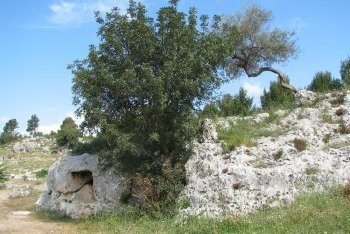
Siracusa owns an old Mediterranean heart in Ortygia, a harbour Venetian or Cretan in its looks. Crumbling buildings, a street market, colourful balconies, drying laundry from the windows: a true delight to the senses. There's nothing else to do than wander the quiet streets, peeking around corners and awe at the ubiquitous churches and palazzi. The attractive and open Piazza Duomo (I found it hard to find at first) has the most prominent buildings.
Like in some of the other places I visited in Sicily there is a lot of reconstruction going on. Ortygia's Duomo is one of the monuments that are under scaffolding at the moment. Don't let this put you off visiting, there's so much more to see. I didn't get into any of the buildings, just roamed around and had a fine time. Siracusa is well on the beaten path for the general tour groups, I noticed even a cruise ship disembarking its passengers here for a visit!
I skipped Neapolis due to an Ancient Greek/Roman overdose I felt coming, but did manage to get to the necropolis of Pantalica. About an hour outside of Siracusa, it can be reached via a scenic road that shows the Sicilian countryside at its best. The drive there on small mountain roads, lined by olive trees and the occasional village (pretty Ferla!) is actually more worth it than the burial site itself. To the untrained eye, the burial chambers that held whole families are merely holes in the …
Keep reading 0 comments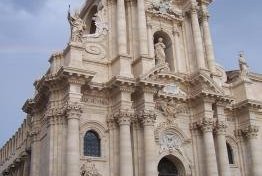
The ancient port city of Siracusa was the main target for our all too brief excursion to South Eastern Sicily, and it was well worth the effort to get there. The heart of the city lies on the island of Ortygia, and as said elsewhere the real charm lies in just wandering around the tight lanes, peeking down narrow alleys and arriving at beautiful squares.
Continuously developed from the 9th Century BC Siracusa was a hugely important Greek colony rivalling Athens, and matching the importance of the Phoenician stronghold of Carthage. Some of the greatest names of Greek civilisation lived here, most notable were Plato, Pindar, Aeschylus and Archimedes. The later actually designed some of the fortifications of the city.
On the main land the ruins at Neopolis were impressive though we only managed a quick peek. We did however investigate the catacombs of San Giovanni, Syracuse is home to the second largest set of Catacombs in the Christian world (after Rome), and they were well worth seeing, especially impressive was the altar from which St Paul is said to have preached.
If there is one monument that best represents Siracusa then it has to be the Duomo (Cathedral in picture), not only does it sit on the most impressive square in the city but also it has developed constantly like the city. It started life as a Greek Temple and the huge Doric columns give it proportion and bulge out from the side they also mark the aisles inside …
Keep reading 0 comments
